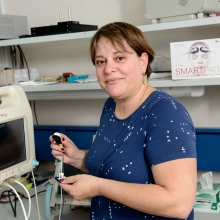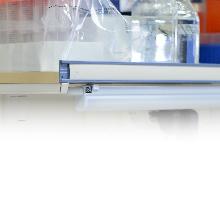A healing solution after brain surgery
Dr. Amir Bahar’s Nurami Medical makes post-op recovery faster, safer
Alumni

Brain surgery is a frightening prospect under any circumstances, but successfully getting through the procedure is only half the battle. Even if the operation itself goes smoothly, the dangers of infection and cerebral leakage post-surgery are high.
One former neurobiology student from the Weizmann Institute has invented a patch for covering the exposed brain that is no Band-Aid solution—hastening healing in a purportedly more hygienic and effective manner than the current animal-based sealant used in brain surgeries today.
Dr. Amir Bahar, who received his PhD from the Weizmann Institute of Science in the labs of Prof. Yadin Dudai and Prof. Ehud Ahissar in the Department of Neurobiology, teamed up with Nora Nseir, a biomedical engineer with a degree from the Technion, to form their company, Nurami Medical. There they developed ArtiFascia—a surgical patch that utilizes nanofiber technology to patch the exposed brain and provide a temporary substitute for the removed dura mater—the thick membrane between the skull and the brain that acts as a protective barrier. Because of its thinness and elasticity, ArtiFascia mimics the dura more closely than alternative bandages, allowing for easier application for the surgeon and quicker healing for the patient.
The standard procedure after neurosurgery is to apply an animal-based collagen bandage to the surgical site and spray it with sealant.
This process, however, is imprecise and time-consuming, and increases the risk of bacterial infections and cerebral spinal fluid leakage. By being self-sealing, ArtiFascia simplifies the bandaging process and reduces the chances of foreign materials finding their way into the wound. Additionally, because it is composed of biodegradable nanofibers and is many times thinner than the animal-collagen product, ArtiFascia does not require removal from the brain, a procedure that increases the chances of contamination. Instead, the patch provides a necessary scaffold for dura regeneration which, once a new membrane is formed, dissolves within about six months.
Dr. Bahar said his path from scientist to entrepreneur started with an incidental conversation with a neurosurgeon at a time when he was eager to initiate a project of his own, and was investigating potential unmet medical needs.
“I learned that doctors don’t have time to think about areas of work that could be improved,” he says. “They simply work with the tools they have. It isn’t until a biomedical engineer sits down and really talks with them that they discover the areas where medical technology is lacking. I learned that cerebral leakage was a major problem that often requires another surgery just to fix.”
With a patent in both the United States and China, Nurami Medical’s surgical patch has a promising future. The first human clinical trials began in 2017 with success. Six patients in the Czech Republic underwent surgery, and all were fully healed at their six-month follow up after using the ArtiFascia patch. A larger clinical study with 90 patients is currently underway.
Not only could this invention vastly improve a neurosurgical patient’s outcome, but the technology behind it has the potential to be applied to many surgical procedures throughout the body.









